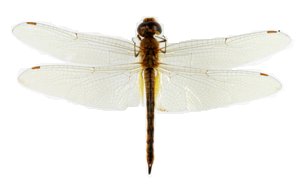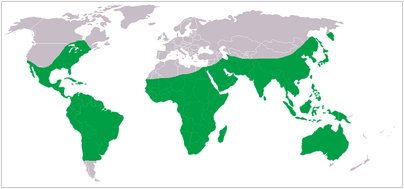 |
| Pantala
flavescens |
 |
|
Common Name:
|
Globe Skimmer, Wandering Glider |
|
Odonata |
|
Order:
|
Odonata |
|
Suborder:
|
Anisoptera |
|
Family:
|
Libellulidae |
|
Genus:
|
Pantala |
|
Species:
|
P. flavescens |
|
|
| The
Name |
| Pantala flavescens, the Globe Skimmer
or Wandering Glider, is a wide-ranging dragonfly of the family Libellulidae.
This species and Pantala hymenaea, the "Spot-winged Glider", are the only
members of the genus Pantala from the subfamily Pantalinae of the family
Libellulidae. It was first described by Fabricius in 1798. It is considered
to be the most widespread dragonfly on the planet. P. hymenaea is restricted
to the Americas.
In the scientific name Pantala flavescens,
the genus Pantala means "all wings," alluding to big and long wings. The
specific comes from the Latin flavescens, meaning "yellowish," refers to
its distinctive golden tint. The English common names "Wandering Glider"
and "Globe Skimmer" refer to its migratory behaviour. The German name Wanderlibelle
mean "migrant dragonfly". In Hong Kong, its name translates as Typhoon
Dragonfly as it arrives with or shortly before the seasonal rain. The Japanese
name is Usubaki-Tombo can thus be translated as "yellow dragonfly with
delicate wings."
The species was first described in
1798 as Libellula flavescens by Fabricius as follows:
The first description of this underlying
Holotype is in the Zoological Museum of Copenhagen University taken from
a female collected from India. In following years there appeared more descriptions
with different names. In 1805, Palisot de Beauvois designated a specimen
from Nigeria as Libellula viridula. Around 1823 the British entomologist
Dale, in an unpublished manuscript, described an allegedly Norfolk-trapped
male as Libellula sparing halli, It is now in the Oxford University Museum
of Natural History. In 1839 the German entomologist Burmeister named a
male collected in Madras as Libellula analis (now in the Zoological Collection
of the University of Halle-Wittenberg) and another male from Brazil as
Libellula terminalis (now in the Natural History Museum of Vienna.) 1910
cleared the field, as Richard Anthony Muttkowski recognized that these
species were all synonyms. A description was made of Sympetrum tandicola
(Singh) 1955 from a male collected in he Himalayas. It remains in Zoology
Survey India, Calcutta and was not recognised as a synonym for Pantala
flavescens until 1973 by Tridib Ranjan Mitra.
In cladistics the genus Pantala is
also placed in the subfamily Pantalinae. There is no up-to-date investigation
of the subfamilies of the Libellulidae which would permit a dichotomous
representation of the phylogeny. From the current state of research, the
Pantalinae cannot clearly be allocated to an subfamily rather than a sister
group.
|
| The
Characteristics |
| The Dragonfly is up to 4.5 cm long,
reaching wing spans between 7.2 cm and 8.4 cm. The front side of the head
is yellowish to reddish. The thorax is usually yellow to golden colored
with a dark line and hairy. There were also specimens with brown or olive
thorax. The abdomen has a similar color as the thorax.
The wings are clear and very broad
at the base. Here, too, there are some specimens with olive, brown and
yellow wings. On Easter Island there are Wandering Gliders with black wings.
The Pterostigma turns yellowish. The transparent wings may turn a yellowish
shade towards the tip. The chestnut-red eyes take up most of the head,
as is usual in the large dragonflies (Anisoptera). The above colors are
certainly an explanation for the many scientific descriptions of this species
under different names.
The larva between 24 and 26 mm long.
It is light green with light, brown speckles. The round eyes are sideways
on the bottom of the head, the abdomen and the tail blunt. The paired side
plates on the eleventh Segmentation (biology)segment of the abdomen, the
so-called Paraproct, is smooth when seen from the side. The unpaired dorsal
plate of the eleventh segment, called the Epiproct, is roughly the same
length as or longer than the Paraproct. This distinguishes them from larvae
of the genus Tramea, where the Epiproct shorter than the Paraproct. Furthermore,
the mouth parts (Palpus) have 12-14 bristles and thus less than P. hymenaea
which has 15-18 bristles.
The female shows some differences
compared with the male (Sexual dimorphism). You can, however, distinguish
between specimens taken on different continents and islands. The general
rule is that the wings of the male are darker than on the females. In mainland
males, the length of the femur, the longest leg section, varies. They also
have longer front and shorter hind wings than the females. The island representatives,
however, have the front and hind wings longer than the female, and the
femur is the same for both sexes. There are other differences between mainland
and island specimens, particularly in terms of coloring. Island representatives
are generally darker.
Pantala flavescens may be confused
with the P hymenaea, the "Spot-winged Glider," but this has a striking
brown basal fleck in the hindwing and is generally slightly darker in color.
It might be taken for a member of the genus Tramea but these usually have
a distinctive stripe on their hind wings.
|
| The
Reproduction abd Development |
| As is usual in the Libellulidae
family, there is no distinct courtship ritual. The females may pair many
times, but usually only once a day. After mating, the migrant dragonflies
fly in tandem, with the female ovipositing while the male remains connected.
This species sometimes selects unsuitable places like freshly washed cars.
A clutch consists of about 500 to 2000 eggs. The eggs spheroid in shape
with the semi-major axis 0.5 mm and 0.4 mm at the smallest points.
The larvae develop within 38 to 65
days, which allows this migrant dragonfly to reproduce in temporary waters
or even in swimming pools. However, the larvae seem to be very sensitive
to temperature. The life expectancy is not known and because of their high
mobility it is almost impossible to determine.
The larvae of the Globe Skimmer,
like all dragonflies, are predatory. It forages very actively and eats
fairly indiscriminately all sorts of aquatic invertebrates such as aquatic
insect larvae and small shrimps (Peracarida). Even tadpoles and small fish
are used for food. The imago eats mostly small insects such as mosquitoes,
swarming flying ants and termites.
Their flight speed is up to 5 m/s.
Especially in the autumn, the Wandering Glider flies in large swarms, using
thermals to advantage. One report even speaks of a "cloud" covering 34
km2. They prefer moist winds. In normal flight, island populations keep
to 2.5 meters above the ground on and stop flying in thermal updraughts.
The continental populations, fly at altitudes of three to four meters and
do not stop flying even in bad weather. Those on Easter Island have evolved
away from their migratory habits because to fly out to the open sea would
usually mean certain death.
When landing, it seeks a vertical
attitude. Like all large dragonflies, the wings are held out from the body
at rest.
|
| The
Distribution |
 The
Globe Skimmer, as its name suggests, has a very wide distribution area,
between about the 40th parallels of latitude or within the 20ºC isotherm
(areas of the world where the annual mean temperature is above 20 degrees
Celsius). In Europe there are only occasional sightings of the species,
with serious evidence to date mainly from the Aegean Sea and the adjacent
mainland. All Globe Skimmer records from England or France are of extremely
doubtful value being, for example, imported with shipments of bananas.
An explanation for the scarcity in Europe of this otherwise common species
is the barrier effect of the Sahara. This makes unfavourable winds, such
as the Sirocco, whose dryness makes dragonfly passage almost impossible. The
Globe Skimmer, as its name suggests, has a very wide distribution area,
between about the 40th parallels of latitude or within the 20ºC isotherm
(areas of the world where the annual mean temperature is above 20 degrees
Celsius). In Europe there are only occasional sightings of the species,
with serious evidence to date mainly from the Aegean Sea and the adjacent
mainland. All Globe Skimmer records from England or France are of extremely
doubtful value being, for example, imported with shipments of bananas.
An explanation for the scarcity in Europe of this otherwise common species
is the barrier effect of the Sahara. This makes unfavourable winds, such
as the Sirocco, whose dryness makes dragonfly passage almost impossible.
Their arrival in the subtropics and
tropics coincides with the Intertropical Convergence Zone. More evidence
of their preference for moist winds, is that the dragonfly migrates to
Southeast India's Tamil Nadu only after the second monsoon which is brings
the rain to that region. In the rest of India, however, it arrives with
the first rain-making monsoon. Observations suggest that they migrate from
India to Africa across the Arabian Sea.
It is the highest-flying dragonfly,
recorded at 6,200 m in the Himalayas. It was also first dragonfly species
that settled on Bikini Atoll after the nuclear tests there.[13] Furthermore,
it is the only Odonata on Easter Island. These individuals seem to be a
small gene pool, derived from the continental populations, which is slowly
creating a new type by Genetic drift. In colder areas like South Australia
and Northern Canada, the species cannot overwinter and must therefore be
replaced by new migrants each year.
|
| The
Protection Status |
The Globe Skimmer has NatureServe
conservation status G5, meaning it is secure (common, widespread and abundant)
worldwide. This status was awarded on 30 December 1985. In the USA, it
has the national equivalent protection status N5. In Canada, however, it
is lower with N4 meaning it is apparently secure - uncommon but not rare
but with some cause for long-term concern. Even at this level, it is granted
protected status in many states of the USA and Canada.
|
|
References:
http://en.wikipedia.org/wiki/Pantala_flavescens
|
| The
Species on Stamps |
|
|
|
|
|
|
Home | Country
List | Species List
|
|